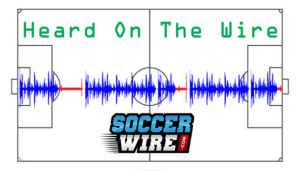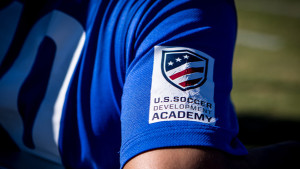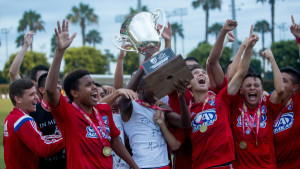High-school dropouts: Will U.S. Soccer’s new girls Development Academy bar school play?
 After a year or so of gossip, and nearly a month after SoccerWire.com’s report of U.S. Soccer’s plans for launching a girls equivalent to the U.S. Soccer Development Academy, it seems as if the official announcement of a seismic new arrival on the U.S. youth soccer scene is imminent.
After a year or so of gossip, and nearly a month after SoccerWire.com’s report of U.S. Soccer’s plans for launching a girls equivalent to the U.S. Soccer Development Academy, it seems as if the official announcement of a seismic new arrival on the U.S. youth soccer scene is imminent.
The federation is set to roll out its vision for a new elite girls national competition at some point in the next week, the fruit of many months of conversations and consideration among U.S. Soccer officials eager to forge a lasting legacy from the U.S. Women’s National Team’s 2015 World Cup championship run. While many details are still to be sifted and settled, the general outlines of this dramatic shift for elite player development are slowly taking shape.
 Sources tell SoccerWire that the new “girls DA” will generally follow its male equivalent – which is widely rated as the country’s premier boys league – in terms of management and substance. That suggests a professionally-oriented environment, 10-month season and top-down infrastructure interwoven with the leadership of the U.S. youth national teams.
Sources tell SoccerWire that the new “girls DA” will generally follow its male equivalent – which is widely rated as the country’s premier boys league – in terms of management and substance. That suggests a professionally-oriented environment, 10-month season and top-down infrastructure interwoven with the leadership of the U.S. youth national teams.
With its planned fall 2017 launch still a year and a half away, leading youth clubs across the country will be able to apply for membership in a process that will start sometime this month or next and run until summertime.
US Soccer expected to officially announce Girls Development Academy as early as tomorrow @TheWomensGame @DanLauletta @JeffKassouf @theECNL
— Glenn Crooks (@GlennCrooks) January 24, 2016
New York-based journalist Glenn Crooks reported on Monday that the federation “will accept 50-70 clubs for Girls DA,” and SoccerWire understands that they will compete in three age groups much like the boys DA has up until this point, likely Under-17/18, U-15/16 and U-13/14. Clubs will be expected to meet and maintain guidelines with regards to coaching, competitiveness, facilities and “a programming philosophy … based on increased training, less total games and more competitive games,” to quote from the stated underpinning of the boys DA in 2007.
 The Elite Clubs National League has served as the de facto girls DA since its founding in 2009 and now regularly grooms 80 percent or more of the players being called in for U.S. youth national teams at any given time. Though many of its member clubs are expected to constitute the backbone of the federation’s league, for the time being ECNL is being bypassed on this new initiative, the concept of which dates back a decade or more, according to one veteran source. At present, both the boys DA and the ECNL have 79 member clubs each.
The Elite Clubs National League has served as the de facto girls DA since its founding in 2009 and now regularly grooms 80 percent or more of the players being called in for U.S. youth national teams at any given time. Though many of its member clubs are expected to constitute the backbone of the federation’s league, for the time being ECNL is being bypassed on this new initiative, the concept of which dates back a decade or more, according to one veteran source. At present, both the boys DA and the ECNL have 79 member clubs each.
Beyond all that, the first question on the lips of industry veterans is a familiar one: Will they ban high-school soccer for the girls, too?
Nearly four years ago DA officials instituted one of the more contentious policies in recent U.S. soccer history when they moved to a 10-month season that barred nearly all its players from participating in high-school soccer.
+READ: Alecko Eskandarian’s compelling read about high school vs. Development Academy
Tired of watching blue-chip players juggle their schedules to compete – and do their best to avoid injury – in school-based competition against and among inferior players, DA coaches and officials asked their pupils for a new degree of commitment. A full-time, club-only environment more similar to international standards was “the right formula” for grooming top U.S. talent, U.S. Men’s National Team coach Jurgen Klinsmann said in a press release announcing the mandate, with “a good balance between training time and playing competitive matches.”
Enacted in early 2012, the change triggered a range of consequences, from bitter complaints to breakaway clubs, especially as exemptions (awarded mainly to students on athletics-based scholarships at private high schools) proved subjective.
+Check out SoccerWire.com’s new College Commitment Tracker
 Widely diverse levels of quality and commitment can be found from region to region in the high-school game. But despite larger crowds and greater social status, it’s generally seen as an inferior standard to elite club play, and with a chaotic schedule to boot. Some geographic pockets where school play remains a cherished and competitive centerpiece of youth soccer, most prominently in Baltimore, saw open revolt.
Widely diverse levels of quality and commitment can be found from region to region in the high-school game. But despite larger crowds and greater social status, it’s generally seen as an inferior standard to elite club play, and with a chaotic schedule to boot. Some geographic pockets where school play remains a cherished and competitive centerpiece of youth soccer, most prominently in Baltimore, saw open revolt.
The social elements of scholastic play tend to weigh heavily for both genders. On the girls side, Title IX regulations have helped ensure proportionately more opportunities to earn college soccer scholarships than for boys – and conversely, far fewer prospects of a professional career, thanks to the fragile, cash-strapped realities of the women’s pro landscape. So the ECNL, US Youth Soccer’s National League and other elite national competitions could scarcely contemplate dictating departure from school play, though club coaches’ lamentations about the negative effects of high-school ball have become a hallmark of sidelines from coast to coast.
Demanding full-time devotion to the girls’ DA league could constitute a powerful statement of intent for the fed’s new initiative. Yet could also inflame long-simmering frustrations and even provoke a confrontation of much greater proportions than the DA’s 2012 decree.
It’s unclear how U.S. Soccer plans to handle this tricky topic, or if its leaders have even made a final decision at this early stage. One source tells SoccerWire that the girls DA project has always been envisioned with a no-high-school commitment for players; another says that the new league will not attempt to mandate this as it finds its feet.
Thanks to the highly-charged legacy of the boys DA policy, there’s effectively no middle path here: Either the federation applies the same no-high-school development mantra to its new girls initiative, or it falls short. Either path promises to antagonize at least one sizeable chunk of the youth community.
SOCCERWIRE MARKETPLACE
- visitRaleigh.com Showcase Series 2025, hosted by NCFC Youth
- OFFICIAL MANCHESTER CITY SOCCER CAMPS
- Wanted Licensed Youth Soccer Coach
- Join Official Elite Summer Soccer Camps with Europe’s Top Pro Clubs!
- The St. James FC Travel Staff Coach - North (Loudoun) & South (Fairfax)
- The St. James FC Girls Academy (GA) Head Coach - 2 teams
- The St James FC Boys Travel Tryouts
- OFFICIAL BAYERN MUNICH SUMMER CAMPS U.S.
- JOIN THE ALLIANCE!
- OFFICIAL FC BARCELONA CAMPS U.S.











